FAT bring together postwar towns and pop culture for British Pavilion in Venice
Venice Architecture Biennale 2014: the British pavilion at the biennale charts the nation's Modernism using a fluorescent pink mound of earth, a galloping horse made from LEDs, imagery of social housing and a pair of concrete model cows (+ slideshow).
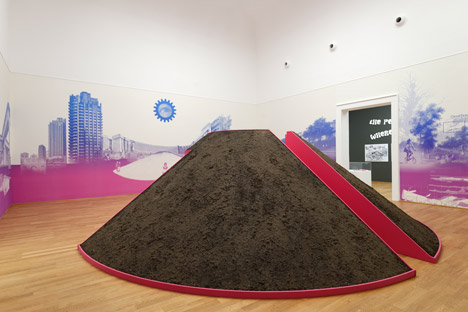
The exhibition was curated by Dezeen columnist Sam Jacob – one third of experimental architecture studio FAT – and Wouter Vanstiphout of Dutch firm Crimson Architectural Historians. Entitled A Clockwork Jerusalem, it encompasses the New Towns created by postwar British planners in the 1950s, 60s and 7os, alongside references from popular culture including Stanley Kubrick movie A Clockwork Orange.
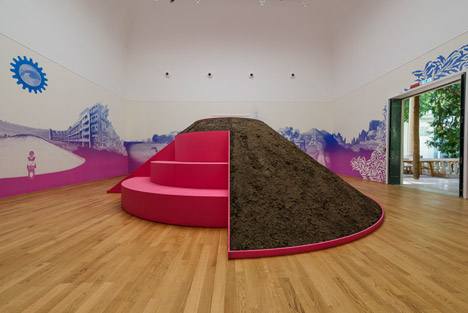
"The ambition we have for the British pavilion is really twofold: one is to tell a historical story, to describe what happened and why, and what it did," Jacob told Dezeen. "But it's also a call to arms for contemporary British architecture, for it to to reengage with the imaginative visions and the entrepreneurial spirit of actually being able to affect change."
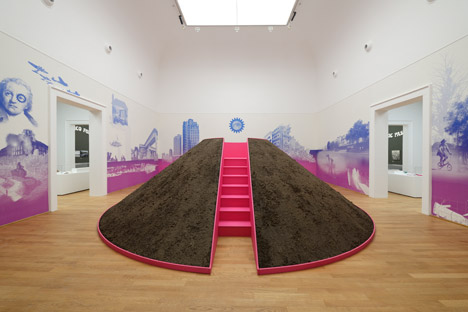
The exhibition uses images, models and artefacts to depict Britain in the aftermath of the industrial revolution. Exhibits vary from Cliff Richard record sleeves to models and photographs of significant housing projects in unfamiliar places such as Hulme and Thamesmead.
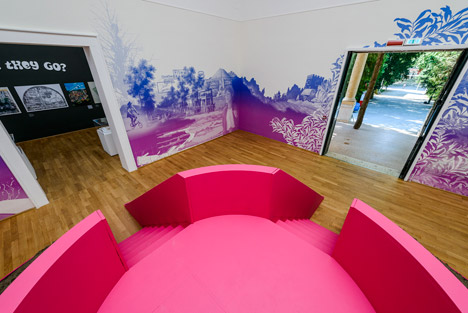
"A Clockwork Jerusalem describes a world where ruins become utopias, where archaeology and futurism merge, the picturesque is reimagined as concrete geometry, and where pop culture, history and social ambition are fused into new national futures. It argues for a rebooting of the British tradition of visionary planning," said Jacob.
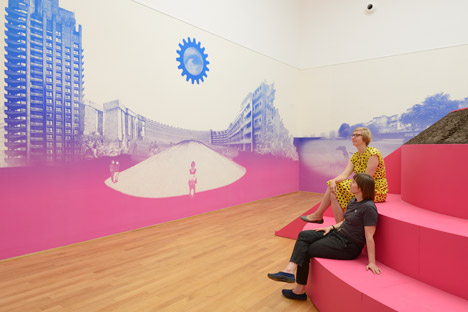
Vanstiphout continued: "Britain sometimes seems to forget its own long history and tradition as a country of town planners, from the New Towns Act (1946) through to the pop-radicalism of Archigram and Cedric Price, and the entrepreneurs – strange cultish groups and activist communities that have also hugely contributed to the national debate about shaping the environment."

At the centre of the pavilion is a seven-metre-wide earth mound, with stairs on two sides allowing visitors to climb on top. According to the curators, the mound was a notable landscaping feature in many housing projects, including Arnold Circus and Robin Hood Gardens.
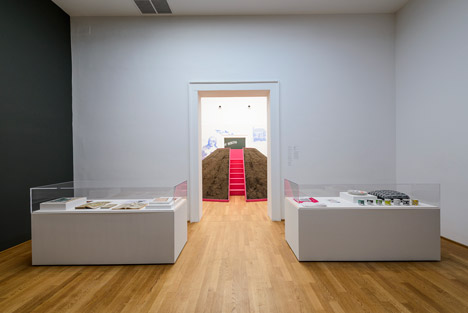
In the spirit of Venetian lions, two cows make the entrance to the pavilion. These artworks were created by artist Liz Leyh in 1978 for Milton Keynes – the most recent of Britain's New Towns.
The wall of LEDs is located beside the entrance and displays an image of a galloping horse, in reference to white horse carved into many British hillsides.
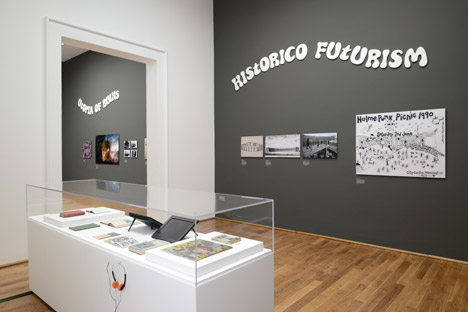
The pavilion was commissioned by British Council director Vicky Richardson.
"A Clockwork Jerusalem is a witty and insightful exhibition that we hope will provoke debate about British architecture," she said. "The exhibition uses images and language brilliantly to link a series of complex issues that we hope will lead to a new debate about the UK's plans for housing and New Towns."
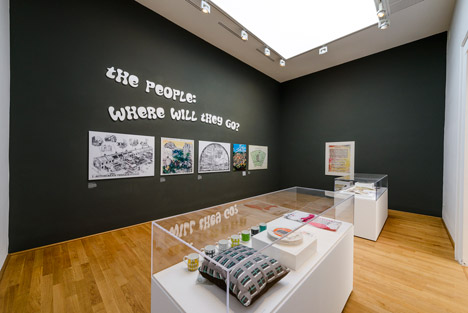
Here's more information from the British Council:
Pavilion of Great Britain opens at the 14th International Architecture Exhibition – la Biennale di Venezia
The British Pavilion was officially opened at the Biennale Architettura 2014, with a ribbon cutting ceremony at 4.00pm today, Thursday 5th June.
Presented by the British Council and curated by FAT Architecture and Crimson Architectural Historians, the British Pavilion's A Clockwork Jerusalem exhibition responds to the theme of Absorbing Modernity: 1914 - 2014, as set for the national pavilions by Rem Koolhaas, Curator of the Biennale Architettura 2014.
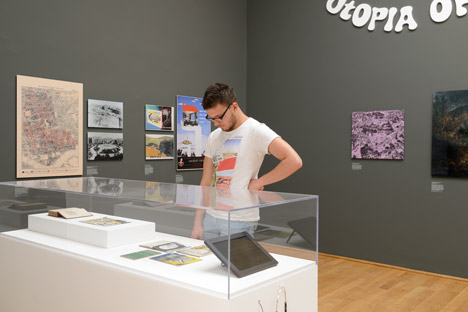
The exhibition explores the origins, projects and experience of British modernity; the culture that post-war architecture and planning emerged from, and the worlds that it created.
A Clockwork Jerusalem explores how a specifically British form of Modernism emerged in the aftermath of the Industrial Revolution. This combined traditions of the Romantic, sublime and pastoral with a fascination and fear of the industry, technology and science fiction to create new visions of society that became the basis for post-war architecture and planning.
The exhibition tells the story of the visions – both real and imaginary – that arose during Britain's struggle to come to terms with modernity, and explores how they continue to inform the nation's physical and imaginative landscapes.
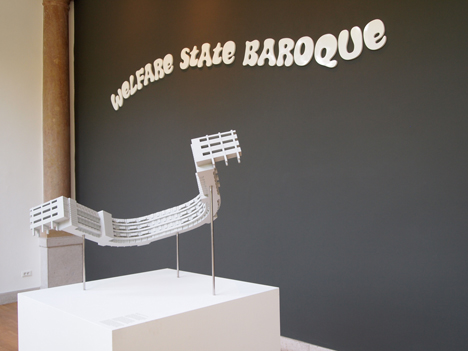
Suggesting trajectories to address the new forms of crisis in a now globalised modernity, A Clockwork Jerusalem argues for today's challenges in architecture and planning to be faced with the same imagination and ambition that has long characterised Britain's attempts to build its New Jerusalems.
Taking the large-scale projects of the 50s, 60s and 70s as a point of departure, A Clockwork Jerusalem explores the mature flowering of British Modernism – the moment it was at its most socially, politically and architecturally ambitious but also the moment that witnessed its collapse. The exhibition chronicles the origins and myths of British Modernism, the products and the cultures it created.

Outside the pavilion, visitors are greeted by a pair of Concrete Cows on loan from Milton Keynes – the last of the post-war British New Towns. Originally produced by artist Liz Leyh in 1978, shortly after Milton Keynes was established, the cows have become unofficial mascots of the town. Shipped to Venice for the Biennale, the Concrete Cows assume a formal position on either side of the entrance to the British Pavilion in the manner of Venetian lions.
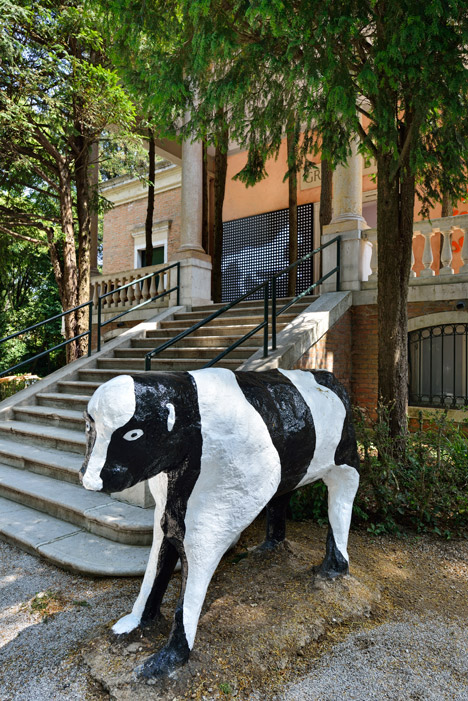
The portico of the British Pavilion has been transformed into an "Electric Picturesque" landscape. Tree trunks installed from floor to ceiling interrupt the symmetry of the Neoclassical pavilion. Seen through the forest is an animated white LED galloping horse, representing a high-tech reworking of the Neolithic white horses carved into British hillsides.
The main room of the pavilion features a 1.5 metre high, 7 metre diameter earth mound and a 360º panoramic image. The mound references thousands of years of British architecture, from ancient burial mounds to the rubble of demolished slums, sculpted into mounds as the central landscape feature of idealistic projects in places such as Arnold Circus and Robin Hood Gardens. The mound symbolises both the beginning and the end: destruction and construction.
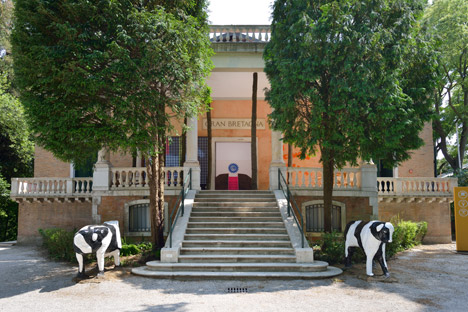
Surrounding the mound is a panoramic narrative image that tells the story of British Modernism, referencing British visual and architectural culture: William Morris, Stanley Kubrick, David Hockey, Archigram and more. The eye of William Blake, author of the words to the famous poem Jerusalem, sits at the centre of the panorama, made up with a cog like a Droog from Stanley Kubrick's famous A Clockwork Orange.
In the rooms around the central installation, images, objects and artefacts tell the story of British Modernism from Stonehenge to council estates, from Ebenezer Howard to Cliff Richard, from ruins and destruction to rural fantasies. Large scale models show three of the exhibition's significant housing projects: Hulme, Thamesmead and Cumbernauld.
A Clockwork Jerusalem will be open to the public throughout the duration of the Biennale Architettura 2014, from 7th June to 23rd November 2014, with a press preview from 5th to 6th June.